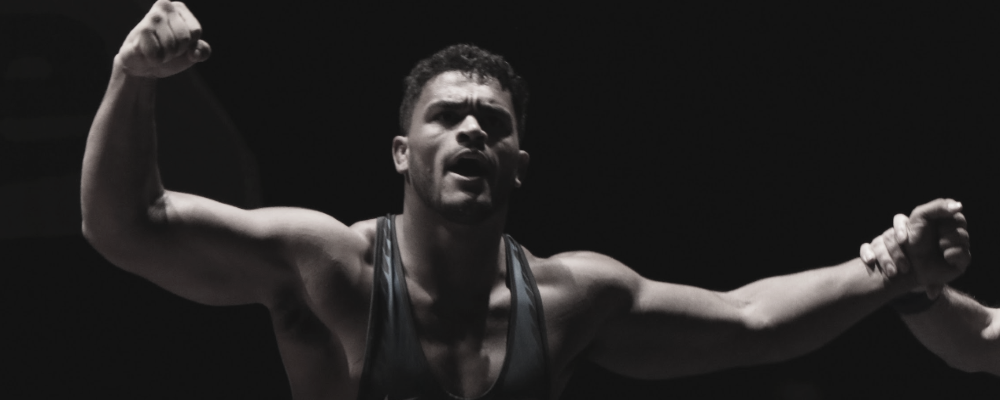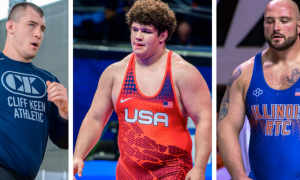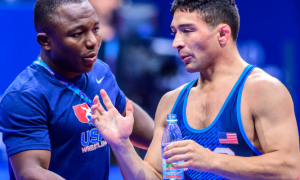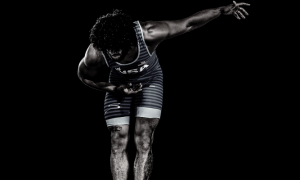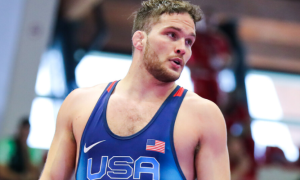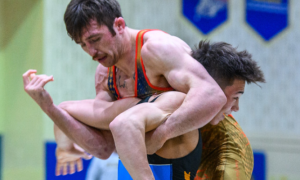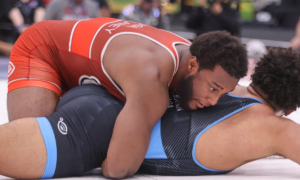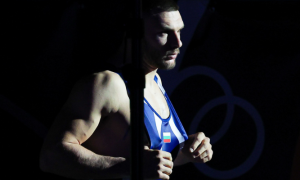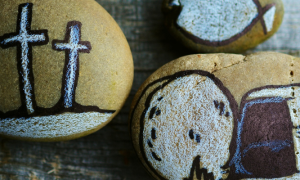All growth depends on activity. There is no development physically or intellectually without effort, and effort means work. — Calvin Coolidge
Tracy G’Angelo Hancock is only 20-years-old. Still only 20 is what you might say, simply because it feels as though he has been around for a whole lot longer than that. On the surface, there is very little about him that makes it easy to digest his age. He has owned an adult’s body for nearly half a decade. Hancock also speaks with an air of intelligent clarity rarely found in other young athletes. That is actually one of his premier traits, his uncanny ability to communicate. He knows how to deal with you on your level, whether you’re twice his age, or some wide-eyed grammar schooler who happens to run into him at one of the many tournaments he has competed in over the past 27 months.
A big part of Hancock’s story is that last point. Beginning in January of 2016, no other United States Greco-Roman athlete has participated in more matches or traveled as much. When you consider how far he has come in such a short period of time, it almost feels like it had to be this way. Except for the fact that this all sort of happened by chance.
2008 Olympian/multi-time World Team member TC Dantzler was alerted to the untapped talent residing inside of Hancock’s DNA by two other former National-caliber wrestlers who had previously served as the youngster’s coach — Marcel Cooper and Pete Hicks. Hancock, whose high school career at Fountain-Fort Carson (Colorado) provided glimpses of the same majestic flair that would eventually accompany him to the Senior level, was fraught with off-the-mat issues which resulted in his dismissal from the team. He was always somebody else’s problem, a bright but misunderstood youth who craved direction more than he did attention. But even though his scholastic ledger rang up an incomplete, Hancock left a deep enough impression on Cooper and Hicks for them to mention his immense potential to Dantzler. “They told me about him, almost in whispers,” Dantzler recalls, muffling his own voice. “So I wanted to see this urban myth for myself.”
It was a slow-moving process at first. Dantzler talked Hancock into training Greco, but the horse needed to be dragged to the water. This was all new, there was hesitance. And trust issues. Dantzler had to chip away a little bit and then lay his cards down in the middle of the table. “Wrestling changed my life and I wanted it to change his life,” he says. “All I really had to offer was wrestling and work. And if you look, wrestling has now taken him around the world.”
Clear as day perhaps, the foundation of Dantzler’s relationship with Hancock wasn’t singularly built on wrestling and the pursuit of greatness. Hancock required the same amount of guidance outside of the wrestling room as he did inside of it. Dantzler collected the teen in his most rawest form determined to set him on the right path. “I’ve been watching him grow from the petri dish, not even the incubator,” Dantzler notes. “There are ups and downs, but people always think it’s all ups. It isn’t, especially for a young black man without a lot of father figures.” So Hancock rode steady with his new coach/mentor/father figure. Their dynamic helped introduce a whole new lifestyle to the upstart, and once things got rolling, they started rolling fast.
Hancock participated in a string of tournaments right away, flashes of his future brilliance once again impossible to miss. It wasn’t about winning (although that occurred more often than not). Instead, just piling on experience while Dantzler prosthetylized about the virtues of Greco-Roman bodylocks were sufficient enough during the nesting period. A big piece of that experience was added on at the 2015 Austrian Open, one of Europe’s toughest Junior Greco-Roman events. Hancock didn’t even really know what he was doing out there but still managed to put in a more-than-respectable fourth. A bigger piece arrived four months later in Fargo, North Dakota, the site of USA’s Wrestling Junior Nationals. This time the color was bronze, but more importantly, his presence at the annual summer mega event opened up doors the kid never would have imagined just a few months prior.
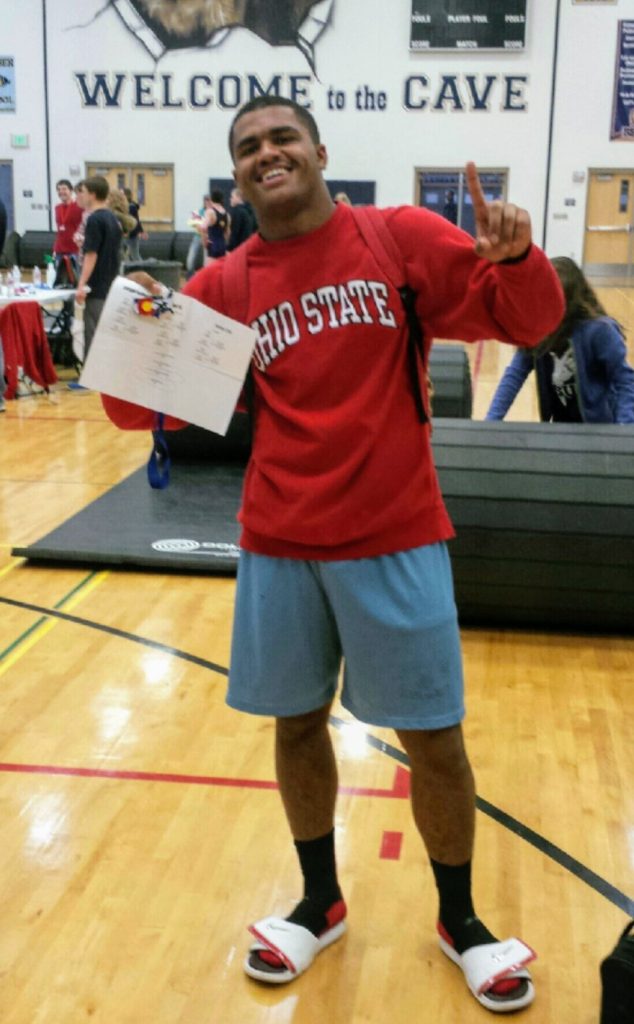
Hancock after winning one of his first Greco-Roman tournaments in 2015. (Photo: TC Dantzler)
United States National Team head coach Matt Lindland and longtime Olympic Training Center residential coach Momir Petković were there at the Fargodome to witness firsthand what the very-green-but-undeniably-gifted Hancock was capable of. They talked to Dantzler. Then they met with the precocious athlete who oozes self-assurance despite often being forced to hide the requisite insecurities every kid from the other side of town has to deal with. You put the package together and it’s too good to pass up: a prototypical upper-weight who possesses an unmatched natural ability to throw other humans combined with all the charm and swagger of a Wall Street hotshot, and the instant consensus is that he is someone you want to see nurtured to his maximum capacity, whatever that looks like.
Before long, Hancock was attending practices twice a day at the Olympic Training Center, though the 25-minute commute from his home in Fountain was a bear on both he and his mother, who did the driving. It wasn’t just the miles. Hancock’s body also started demanding more calories due to the uptick in training, and money was scarce around the household to the point where his dietary needs became too substantial to afford. How long this routine was going to hold up, no one really knew. Not forever. Fortunately for everyone, Petković stepped in and offered the ultimate solution: Hancock would become a resident athlete at the OTC. No more commuting, no more wondering what and when the next meal is, and best of all, virtually unlimited access to all of the many resources available in the facility.
Chances are, you know what comes next. In just over two years of full-time Greco-Roman training and competition, G’Angelo Hancock has made appearances at four World Championships across three different age groups, including a bronze from the 2016 Junior event. He has earned 11 overall international medals with seven golds. Domestically, Hancock has been a downright nightmare for opponents, possessing National titles at Junior, University, and Senior to go along those with four World Team Trials tournament victories.
Greco-Roman doesn’t track individual records the same way boxing or mixed-martial arts does, there is already more than enough bookkeeping to occupy the lot of us. But depending on what events you are willing to account for, Hancock’s competitive record dating back to January of 2016 stands at a startling 67-12, with the majority of those 67 wins coming well before the final whistle. And also unlike boxers or MMA fighters, there is no “protection” for Greco-Roman athletes, no waiting until a certain number of fights have been logged against less-than-stellar opponents so as to build confidence (or monetary value). You face whomever is available, whenever, wherever, no matter their credentials. As you will see in Hancock’s case, often times the guy standing in the opposing corner checked a whole lot more resume boxes than he — a difference between combatants that becomes negligible upon the first contact, however.
What you are unable to glean from all of the matches, medals, and pats on the back is the personal element. Everything else is just a dataset, compartmentalized numbers that we can all nudge our heads toward for no other reason than to paint a hurried picture of what an athlete is or isn’t. But it’s the person’s own perception of moments and milestones that truly offers a tale well-told. Emotions are fleeting, they pass through the consciousness and inevitably fade into the nether. We remember them, though. We remember how we felt when something notable occurred, what it meant at that particular space in time, how we are better, worse, and what we learned from having climbed another rung on the ladder of our lives.
That’s why we have this.
The following is G’Angelo Hancock, in his own words, detailing each competitive month of his career from January 2016 onward, for it was the beginning of that Olympic Year when everything started becoming just a little more serious. As you progress through the months you will see how Hancock’s perspective begins to shift. His expectations change congruently with his accomplishments and experience, his successes and disappointments. Nothing is spared. Hancock recounts every pivotal moment over the past 27 months with unbridled honesty in effort to provide a full scope of what he was going through as his career began to ascend. If you’re entering into this with preconceived notions about who this man is and what he values, prepare to have them smashed.
An Oral History Of G’Angelo Hancock’s Career: 2016-Present
January 2016
Hancock started the year knowing that he was working with obvious potential. Having now been a resident athlete at the US Olympic Training Center for several months, the resources were all in place to facilitate his climb. That doesn’t mean there weren’t bumps in the road, especially in the beginning phase. For example, Hancock endured two straight losses to the same man over the course of a week. At both the Jack Pinto Cup and the Dave Schultz Memorial, Kevin Mejia Castillo of Honduras, an experienced Senior competitor who by that point had already made an appearance at World events across all three major age groups, introduced Hancock to the differences foreign athletes tend to offer.
Hancock: “I learned the seriousness of competing at this level. Kevin comes out like a freaking animal. In all reality, after losing to Kevin there were a lot of insights, a lot of internal thinking. What my dad would call ‘soul searching.’ After something like that, you do a lot of soul searching, asking yourself, How bad do you want it and what does it take to get there?
“What’s crazy about it is that at the (2017) Pan American Championships I destroyed Kevin and I realized the amount of work it takes to get there. Because the amount of work that I had put in from January of 2016 to when I wrestled him again was astonishingly different. The amount of training I put in was completely different. 2016 was a whole new year of spartan training that completely changed it all, changed everything.”
March 2016
Hancock was just a newbie in 2015 when he took his first trip overseas to compete at the Austrian Open. But those jaunts to foreign countries are rarely about the tournaments anyway, US guys use them mostly for the training camps that (usually) follow. Even still, 2015’s running of the prestigious tournament saw the very-raw Hancock come away with a fourth-place finish. Not bad for a kid who was just beginning to learn the ropes.
A year later it was a step up. Hancock snagged a bronze, his first medal won in a foreign zip code. His only loss at the tournament, to Georgia’s Giorgi Melia, would offer greater significance later on in ’16, but for the moment, Hancock’s performance delivered a notable sign of encouragement ahead of the most critical points of the season.
Hancock: “This was like the whole kit and kaboodle. This was where I really started seeing it, what I might be capable of. It was my first overseas medal. That right there let me know that I can do this, that I’m taking steps forward. That medal made me different. Specifically because what do we hear about in the US all the time? It’s always, Bring back a medal, get your medal, bring your hardware back. I finally felt like I did something the right way, took the right step.
“I was moving in the right direction. I was finally beating Europeans, I was finally beating international competition — and not in America — because it’s easier to win when it’s on your own turf. But I won on their turf and that was deep to me because it meant if I could do it home and I could do it there, I could do it anywhere.”
April 2016
There were two primary favorites to win the 98 kilogram class at the 2016 US Olympic Trials and Hancock wasn’t one of them. But he would still find a way to make an impact. He won his first match of the morning, a cruise-control tech fall win over collegiate star Jake Kasper to set up a semifinal meeting with multi-time World Team member and eventual runner-up Caylor Williams. Williams romped to an 8-0 victory, but that was to be expected. Undaunted, Hancock quickly regrouped and came away with wins in his next two bouts to ultimately place third and lock down a spot on the Senior National Team at 18 years of age. It was the first of several watershed moments to come throughout the year.
Hancock: “I was a young guy and beyond nervous, just out of my mind. But honestly, I’m thinking, Is this my time to make history? Is this my time to be great? I’m coming into the tournament, what am I, 18? I was just like, Tracy, this is it. You can do this, you can make history.
“Everyone knows TC Dantzler is one of my closest allies. He’s very blunt with me and he’ll never, ever hold back from the truth. That’s one of the reasons why I love him the most. After I lost to Caylor in the semis and I was going to the back, (US National Team head coach) Matt Lindland was trying to calm me down. TC disagreed. ‘No, no! Don’t tell him that.’ He was very honest with me. He said, ‘You were scared to win.’ At the time hearing that, it doesn’t hit yet. I’m like, No, I’m not afraid to win. Shit, I’m wrestling, I’m a bad dude, just like everyone else here. Why do you think I’m wrestling? But the fact of the matter is, I was 18. I’d be ignorant, I’d be lying to myself if I said I wasn’t scared.
“You see Caylor Williams around and it’s 2016 at the Olympic Trials, you’re going in there with a mindset that says fight or die. You either come home with your shield or on it. That’s how I felt going in there. I knew who Caylor was, I saw him around the US at the time. He was relentless on the mat. He comes off very aggressive. He’s mean, he’s strange, things like this. I’m thinking in my head, Okay, I’m going up against Caylor Williams. I have to be an absolute savage. That’s what was in my mind.
“TC gave me a pep talk. I don’t want to say too much about what was actually discussed. This is man who is a part of my life, he’ll always be a part of my life. 30 years into the future when I look around, TC will still be a part of my life. But it was him. He fires me up. After he talked to me I had to dig deep and realize that, I lost, yeah. But I’m still at the Olympic Trials and I have to show people why I’m here. Who am I to be someone where it’s like I lose and that’s it, I’m done? So that was my motivation. I was still at the Olympic Trials and I still had something to prove.
“When I made the National Team, that was huge. I got off the mat and gave TC a big hug. And I know nothing of it. I didn’t know. Now I know, you get a check (laughs). It meant I could go travel much more often. I didn’t know I was actually going to get paid for wrestling. That was the first time in my life I ever received money for wrestling. It was like, This is deep. This is a career, you could make a living off this.”
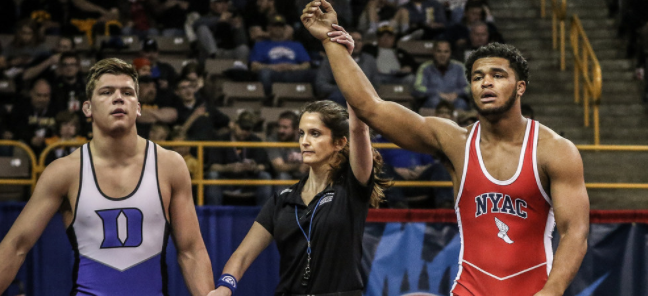
A then-18-year-old Hancock started off the 2016 US Olympic Team Trials with a victory over Duke star Jake Kasper but ran into trouble against Army standout Caylor Williams in the semis. (Photo: John Sachs)
Making the National Team instantly jumpstarted Hancock’s stock, especially due to his relative youth and little time logged in the sport. But it was as a Junior competitor where his highest highs of the year would be realized. That process began at the Junior World Team Trials in Las Vegas. Hancock found little trouble advancing to the best-of-three finals on the strength of a pin and a tech fall. He punched his ticket to the Junior Worlds later on by defeating Angus Arthur in two straight bouts via tech, and the implications of such an achievement weren’t lost on him.
Hancock: “This is one of the proudest moments in my career. It was my first team. Don’t get me wrong, it’s cool when you’re on the National Team — I’m third down the line, I’m ‘the guy’, I’m third in the USA — but when you make a World Team, you are Team USA. You walk differently. And it is not at all meant to come off as bragging or cocky when you see someone, but you want to carry yourself higher. You want to be a better person because now your name means more than just your name.”
May 2016
Hancock approached the latter part of the spring with a fresh sense of enthusiasm. Two of the year’s most important tournaments were behind him, and with the World Championships still a few months away, there was time to focus on shoring up technique and adding even more nuance to his ever-growing arsenal. But that didn’t mean he was taking a competitive break. At the Community Youth Center in Concord, California arrived the annual Junior Greco World Duals, a two-day event that also included an arduous training camp that in 2016 was presided over by Mark Halvorson and his coaching staff, as well as the newly-minted US Olympic Team. All told, Hancock wrestled in nine bouts over those two days, winning each one of them on his way to the individual title at 96 kilos.
Hancock: “Coming off of Concord, I started to sense like I was developing my feel, you know what I mean? Because what I was doing was starting to work. It wasn’t as if there were situations where I’d be in a scramble, something weird happens and somehow I still come away with points. I realized that my actual moves were working. And from that, I learned that I have a feel. Aside from learning the foreign feel, I started to realize that I had my own style of wrestling.
“I also learned that I’m in the mix. I’m learning and getting my international body count and my international match count higher and higher. I was able to start developing my style without realizing it. This was where I began really building my style of wrestling. Before, it was always Straight to the bodylock, straight to the bodylock. Or straight to the reverse lift. But Concord, this was where I began witnessing how my moves work and how to set them up. Now I’m hitting stuff on guys who are going to fight back, whereas other guys before maybe didn’t fight as hard. That’s why this event helped me learn my style.”
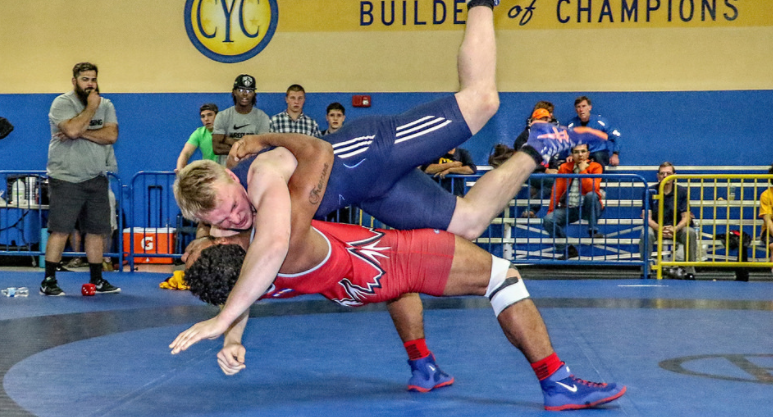
The Junior Greco World Duals, held annually at the Community Youth Center in Concord, California, offers athletes an intensive week-long training camp followed by a lot of matches. Hancock wrestled in a full series of team duals on Friday and then blitzed through the individual tournament on Saturday, emerging with a 9-0 record overall. (Photo: John Sachs)
June 2016
Up next was the University Nationals/World Team Trials in Akron, Ohio. It was another laser show of sorts for the wunderkind. Hancock blitzed his way to the best-of-three finals where he brushed past Orry Elor (NYAC) twice in a row via tech (Hancock had also beaten Elor for third place at April’s Trials). The tournament victory was supposed to result in another World Championships later on in the year, though eventually that wouldn’t come to pass, as the US declined to send the University World Team to Corem, Turkey due to security concerns.
Hancock: “This is right around the time when my experience with foreigners started helping solidify my approach against domestic competition. Let’s be honest — if something is going to work 70% of the time, 60% of the time against a foreigner, that translates to 80 or 90% against a domestic opponent. When I am hitting these moves on an international guy and they’re working — they are flowing, it’s becoming chain-wrestling, and the style is starting to take hold — then yeah, these moves should work against US opponents.
“But absolutely, I am realizing that I should be the guy in the USA and that I very well could be the guy at the Worlds.”
August 2016
The United States was sending one of its best squads in several years to the Junior World Championships in Macon, France. Along with Hancock were fellow young stars such as Taylor LaMont, Kamal Bey, Dalton Roberts, and Randon Miranda, so the idea of the Americans coming back with a haul of hardware wasn’t exactly far-fetched. While most everyone on the team wound up acquitting themselves well, it was LaMont and Hancock who took the highest billing by capturing bronze medals in their respective weight classes.
A 6-1 decision over Ravi Ravi (IND) and a quick disposal via fall of Nizami Shamilov (AZE) had put Hancock in the semifinal opposite Georgi Melia (GEO). Melia wasn’t anonymous; the year prior, he defeated Hancock at the Austrian Open. This was a different year. In a wild, back-and-forth first period, Hancock got caught in a Melia headlock only to quickly find his footing in time for a four-point throw. Melia repaid the favor to jump back ahead, but just before the bell sounded for the break, Hancock swooped in for a takedown to cut the deficit to 8-7.
Another headlock by Melia widened the gap once shortly into the period and from then on the action slowed down considerably. A passivity point went in Hancock’s direction eventually, but that would be it, with Melia advancing to the final via 12-8 score. Hancock rebounded nicely for bronze, though he wasn’t completely himself. In what was a tight, grind-it-out affair the whole way through, he bullied Japan’s Yuta Nara (JPN) to emerge victorious 3-0, sealing his first steps onto a World podium.
Hancock: “I had a feeling in Austria (against Melia the year before) that it was just out of reach, it was a figure too far away. I knew what this guy had so I was going into that match thinking, This is the kind of match I want to have at the end of the tournament. This was a semifinal match, so I was happy it was taking place right here and right now.
“I was talking to Coach Lindland and I’m like, This guy has a good headlock, he’s got a good headlock. So Matt said, “Well, you can’t go out there thinking about getting headlocked, you have to go out there and just wrestle. You know it’s coming, but don’t anticipate it.” The whole time I was wrestling him I was just trying to stay focused, just wrestle, wrestle, wrestle. When he hit the headlock I was like, Damn, he got it. But okay, whatever. Everytime he hit the headlock there were sparks that fired off. Like, Okay, he got four points, it’s time to fire off. Everytime he got the headlock, I responded. There weren’t as many points, maybe I got a takedown or a correct throw. But that was the mentality I had during the match.
“You go over there (to the Junior Worlds) on a team with my little bro Kamal Bey, the beast Taylor LaMont, and you just have these guys who are capable of doing great things. You kind of take on this embodiment that it’s bigger than you. It’s just a feeling that it’s so much bigger than you. You feel like you could take a home a team championship, not just a medal.
“So it hurt. It hurt bad. Seeing myself fall out of the tournament, I’m thinking, Man, maybe these guys are looking up to me, but I was also looking up to them. Falling off like that made me feel as if I had to come back for that bronze. Initially I’m like, This sucks. You go to the World Championships because you want to be the best in the world. That’s why losing hurt so much. As wrestlers, we train for this all year. We put four years of work into one dang day at the Olympic Games. And that was the feeling I had after the match with Melia, like I had let down a full year’s worth of training. I had been training so hard for this but that is also why I had to come back, I had to get something before I left. To prove I did something.
“That loss to Caylor put it in my mind that I lost to him when I did for a reason. It flashed back to TC’s pep talk. It runs through my mind before every single match — Am I going to give everything? Did I give everything? The things he said to me were constantly on repeat leading to the bronze match because it hurts, especially when it comes to your coach who you look up to and he wants to see you succeed. His words definitely affected me a lot.
“When I was actually going for the bronze I felt a much lighter load than I had prior during the tournament. When they told me I was wrestling for bronze I was happy, I was excited, and I was like, Now it’s time to show up, you know? Now Tracy! Bodylock! I was thinking, Now’s the time for big throws, to secure my positions and absolutely shut it down. And then I got out there for the match and I’m up two points, three points, and instead I’m thinking, Tracy, secure the ‘W’, it’s not about showing off. Just SECURE the win and get what you came here for. So I wasn’t too worried, I was excited to be there and represent.
“I don’t think that the World bronze medal has ever hit me. I don’t find that as something to be too proud of because I had such a goal. I’m happy, but not satisfied, that’s how I’d say it. While standing on the podium I got to watch the American flag go up over so many other flags, but I also got to see two other flags rise up above America’s. At that point, it turned a hunger into a passion. I knew then that I do want to do this for the rest of my life. I want to see our flag on top of every other flag when I compete. Right there in France is when my mindset changed regarding what I want to do with this wrestling career.”

Hancock’s march to Junior World bronze: scrapping hard against an attempt by India’s Ravi Ravi; giving credit to Giorgi Melia (GEO) following their turbulent bout in the semis; and looking to throw Yuta Nara (JPN) with his patented bodylock in the third-place match. (Photos: United World Wrestling)
October 2016
Hancock’s first forays back into competition following his Junior bronze arrived in the fall and in a different country. Along with a large number of wrestlers from Northern Michigan, he ventured into two events that offered their fair share of challenges, the Klippan Cup and Malar Cupen. Hosted annually in Sweden, both tournaments deliver just what US athletes need: plenty of matches against international opponents. Hancock dominated his way to gold at the Klippan Cup, which represented his first Senior tournament win overseas. The next weekend’s Malar Cupen saw him make the final only to fall to Leon Kessidis (GRE) via tech.
The importance of the trip was two-fold. Hancock absorbed more foreign training and showed that he still carried the same zeal for competition that helped him earn his bronze. Going back over to Europe so soon after the summer was a little bit of a gamble, but one that he assumed would pay off later on.
Hancock: “I guess I compare it to tattoos. When you’re going through it is, Man, this hurts. Why am I cutting this weight? Why am I sweating and bleeding for this? Why am I in the sauna for two hours? But then after you wrestle, you’ll say, Let’s do it again! I’m ready to get back out there! That’s why I liken wrestling and traveling to tattoos, because although it hurts at the time, it’s always worth it at the end and then you want more.
“After the Junior Worlds the passion had just built up. I felt like I hadn’t earned the right to just chill. I didn’t come back home a World Champion, and so I didn’t feel like I deserved a month off. I came home, took three days off, and got right back to it immediately. That was what had to be done in order to take steps. Satisfaction leads to stagnation.”
November 2016
Business was booming. Rather than slow down, Hancock jumped right back into the thick of things by reemerging stateside immediately upon his return from Sweden to win the Bill Farrell Memorial.
It was also at the Farrell where he became acquainted with Hayden Zillmer (Minnesota Storm), the iron-tough graduate of South Dakota State who like Hancock, also turned heads in Iowa City. Fresh off of his final collegiate season, Zillmer entered the Olympic Trials almost as an afterthought despite solid experience previously. Any skepticism that remained ended when he decisioned 2015 World Team member Patrick Martinez (NYAC) for third place and the 85-kilogram National Team spot in Iowa City.
The battle between Hancock and Zillmer in the finals of the Farrell ultimately became a pattern that played out numerous times throughout the year. But the initial clash that started it all was a memorable one, even if a total of three passive points dictated the result. Physicality was the order of the day because it had to be. Their styles didn’t mesh, but that’s what made it compelling to watch. Hancock, the more fluid of the pair, found Zillmer’s hard-charging mechanics a difficult puzzle to solve. Neither allowed for many openings one way or the other. Hancock might have had his hand raised, and that meant something, it was his first Senior gold in the US. But he also would also come to find out that Zillmer was someone deserving of being taken seriously.
Hancock: “That caught me by surprise because he (Zillmer) was coming off of folkstyle and I thought he was indecisive as far as what he wanted to do, Greco or freestyle. I think he is still undecided, especially with Greco, so I wasn’t showing him the time of day just because Greco is a sport where it’s all-in or nothing. Of course, then I started realizing over time that Hayden, I think he’s all-in (laughs).
“After the Worlds it was a big reset. It was like, Hey, forget the Worlds, it’s in the past, you can’t change anything about it. I forgot about the losses, forgot about the tournament. It was a new year, a new season. I wanted to set new goals and go after those. Coming into the new season, the New York AC was the first stepping stone. It was a confidence-builder. The NYAC, you know, it’s a tough tournament. But we’re training for the bigger stages — the Worlds, the grand prixs, and whatever else — so winning the NYAC sort of gave me a feeling like, Good job, let’s just keep moving. It was a sign that things were still headed in the right direction.”

A quarterfinal win over Masato Sumi (JPN) broke the ice for Hancock at the 2016 Bill Farrell Memorial, where he eventually made the finals opposite fellow National Team member Hayden Zillmer (Minnesota Storm). The two would meet four more times over the course of the season, including in the best-of-three finals at the World Team Trials. (Photos: Frank Gioia)
December 2016
December brought with it more milestones. The second annual World Wrestling Clubs Cup, held in Budapest just ahead of the Non-Olympic Weight World Championships, saw the US pitted up against a collection of other teams all bearing the names of various national clubs (rather than representing their home countries). It is part of the event’s uniqueness. In some cases, athletes even suit up for nations not their own, giving international wrestling a taste of the free agency rules that exist in other professional sports.
For his part, Hancock went 3-1 in his matches throughout the two-day dual meet format, though Day 1 is when he made the most headlines. In the dual versus Istanbul Büyükşehir Belediyesi (Turkey), he faced off with Cenk Ildem, who was fresh off of earning a bronze at the Rio Olympics. There wasn’t a lot of action in this one. Ildem grabbed a 1-0 lead on a passive when moments later, tried bullying in on Hancock with his left hand dropping low — very low — low enough to mash Hancock in the groin. A caution-and-two rang out in Hancock’s favor and the upstart managed to hold Ildem off the rest of the way with some busy pummeling to notch the biggest win of his career up this point.
Hancock: “Not looking past him (Ildem) was the hardest thing about that match. It was weird because I’m entering that event and Momir is rubbing my shoulders, giving me massages and Coach Lindland is prepping me for my matches. They’re both telling me to relax and have fun, to just go out and wrestle.
“But I remember before we wrestled Turkey, the vibe had changed. I’m over here thinking I’m going to kick this guy’s butt. I wanted to put him in the ground, so I’m all just, Okay, whatever. But it was a totally weird feeling. I walk on the mat for the match and Ildem comes out. Immediately I’m just thinking, Damn, this guy is big, he’s huge. I had never seen him before.
“Honestly, the biggest advantage I had going into that match was my coaches not telling me who he was. So I go out there, and honestly, I’m just wrestling him like I would anyone else. As soon as that whistle blew I made first contact. I was trying to be mean. Look at the guy, he’s big, he’s strong, so I felt like I should go out there and be mean first. I was definitely underpowered so I kept telling myself, Stay in position, don’t look past him. My goal was to keep circling and no matter what, look like I was always standing in the circle so I had the best positioning.
“Anyone who watched Matt (Lindland) and knows how he wrestled could probably automatically tell that he was also a UFC fighter. The way he wrestled, it was just nasty (laughs). He was going after people, he’s tough, he’s mean as hell, and to him it was more like a fight than a wrestling match. And that’s fine by me 100%. During the break, Lindland tells me, “We’ve got to make this a fight, Tracy.” Because, I don’t want to say that I didn’t have enough technique to take him down, but when you have two big guys battling out there like that, sometimes the only way to get him down is to wear him down or tear him down.
“In the corner, Matt was saying, We’ve got to turn this into a fight. That kind of gave me a TC moment just because TC would always say these motivational phrases. I don’t know what it is about him, he could always just fire me up like nothing. So when Matt is telling me all this, I’m listening to it and like, Okay, yep, time to make it a fight.
“When I went back out there I just started going crazy. We were going for underhooks and from my side, I’m throwing uppercuts and he’s throwing haymakers. We are both taking it to the ribs, fighting each other’s chin and just seeing who is going to wear down. When Ildem went for one of his uppercuts he wound up punching me in my private parts and whatnot. The funny thing about it is before I ever hit the ground Lindland threw the challenge cube — because, with his style of wrestling he already knew what Ildem had just did (laughs). Before I was ever lying on the ground and holding myself, he already had that challenge out there. That was the coolest thing ever because I knew we were on the same page there. I had really good corner support for that match, really good corner support.
“Coming straight out of the match felt differently than it does at any other tournament because the coaches were congratulating me and hugging me as if it was this huge accomplishment. I was confused, I’m just like, Hey, it was just another match, guys. I’ve got two more. They’re saying, No, you just beat an Olympic bronze medalist. So now my head, I’ve got to grease it to get through the doors. I’m happy, I’m feeling like the man, just thinking, Oh, I’m going to kill all these guys, just slay ’em all!
“And then in my very next match I wrestle Ukraine and I kid you not, this guy was short. He’s probably shorter than (Ben) Provisor. He was just tiny. But he was also stacked. I’m all like, Okay, I’m just going to go step on this little M&M. I go out there and get tech’ed in 20 seconds. It was drastic how my mindset changed. I was trying to figure out what went wrong with me, what went wrong with the match. When I walked off the mat I went over to Coach Momir and I was just quiet. I didn’t want to talk to anyone, I just wanted to be quiet. I looked over at the coaches and so now I’m just waiting for Momir to say something. He’s very philosophical and if you wait long enough, you’re going to get what you want.
“So Momir comes up and he tells me, ‘Tracy, I’m so glad you did not win that match.’ At the time, I’m pretty mad and I look at him like, Why would you even say that? He sees my face and just goes, ‘You weren’t ready.’ Sitting there, I’m thinking in my head how I don’t know what he means. I didn’t. But comparing how I felt after winning the match before to how I felt just then, I understood. I had something to learn mentally. Like today, I feel 100% ready to take on the world. Of course. But at that point in time, there was something else that needed to be learned, and I think it has. I think it has been learned.”
Once again, there wasn’t time to relax. Just a week after returning home from Budapest, Hancock had the US Senior Nationals in Las Vegas. With Rau still out of commission due to knee surgery and Williams focusing on his Army career, he was now the prohibitive favorite to win the 98 kilogram class, if not do so fairly easily. It all went according to script to start off as Hancock picked up quick tech wins over Trent Osnes (Marines) and James Souza (Army/WCAP) en-route to the finals where another showdown with Zillmer awaited.
Similar to their initial meeting, Hancock was able to grit his teeth just enough to come away with a narrow victory on the strength of two passive calls. There was just a tiny bit of heat between the two upon the last whistle, a little shove, maybe a word or two. It was nothing crazy, but interesting if only for the fact that across two bouts and 12 minutes of wrestling, a rivalry seemed to be brewing in full — even if Hancock wasn’t ready to concede as much just yet.
Hancock: “Honestly, at the time…I’m not going to say I’m much different, but I’ve gained a lot of maturity through wrestling, specifically as a Senior. I think maybe at that time it was because I truly believed I was the guy. And that’s not my confidence talking, that is me just being honest, although that confidence is there. It’s more that I believe every time we wrestle I won’t allow him to be my rival. To me, a rival could take your spot, and in my eyes, that spot was always mine.”
February 2017
Here we go again. For the third time in three tournaments, US fans were treated to another running of the Hancock/Zillmer saga. The difference was that in their finals match-up at the Dave Schultz Memorial, Zillmer not only scored offensive points but also owned a 5-4 advantage heading into the bout’s waning moments. Hancock, in hot pursuit and looking to engage, caused Zillmer to retreat. The result was a caution on Zillmer and two points for Hancock, who walked away with a nail-biting 6-5 victory.
Hancock: “This was when I realized that I’m getting scouted. It is also when I realized that the moves I hit are going to be detrimental to the moves that I’m allowed to hit at bigger tournaments. It is also when my coaches are telling me to be smart, but that was after the case.
“During the match, I realized that my reach-arounds aren’t opening him up anymore, that my drags aren’t setting up my bodylocks anymore. So it is occuring to me that, Okay, I’m starting to wrestle this guy way too much. It was just a fight, just a wrestling match at first — until he took the lead. I spazz, you know? Whenever I go down in points I tend to spazz. I was thinking, Get back, get back, get back. The best time to score is after there has been a score. Either after he scored or you just did.
“So I immediately attacked, attacked, attacked and I’m realizing, We’ve kind of figured each other out here. I’m not going to wonder if he’ll wait for me to open up, that’s not how I wrestle. When I get down (on points), the one thing I’m thinking is, I’m not going to be able to beat him on an easy score. Instead, I have to expose him. The only way I thought I could do that was to make him look as passive as possible. If he’s not letting me in? Show the ref. Everything that he is doing to me I have to show the ref. Because he can’t feel what I feel, so I have to show him.
“It got to a point when there was about 1:30 left and in my head it’s, Tracy, you’re going to have do this now. For me, that last minute is vital, it is a tone-setter. It sets the tone for what one guy is going to do for his last minute and what the other guy has to do for his last minute. I didn’t want to go into that last minute without being up. And I knew if I could expose him and take the lead, then it would be he in that last minute who needed to do something. It’s a big strategy. With me being the attacker the whole match, it kind of put it in my head that there is no way the ref is going to call me (passive) in the last minute.
“I had to put those things together. It was a really strategic game and wrestling had never really been that way for me before. These back-to-back-to-back competitions with Zillmer I feel improved me a lot because I had to learn to wrestle strategically. Now I have to watch film, now I have to be an adult, I have to be a student of the game. I actually thank him for that, Hayden made me this way (laughs). As he studied me, now I have to study not just my American opponents, but everyone else, too.”
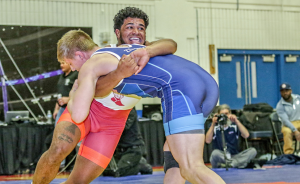
Hancock was forced to press the action late in his third meeting with Zillmer in order to pull out the win. It was also this bout when Hancock says he realized that he was being scouted, which taught him a valuable lesson about preparing for international opponents. (Photo: John Sachs)
March 2017
If Hancock’s bronze at the ’16 Austrian Open delivered a career milestone at the time, then his win a year later was all but a seeming formality. From start to finish, it was a pronounced display of dominance as he stormed his way through the 96-kilogram bracket on the strength of three technical superiority victories. The US squad as a whole enjoyed a record-breaking day in Austria with six champions and 12 medals overall.
Hancock: “When you get put with a team that can do great things, you kind of have to step up to the plate. I had earned the bronze in ’16 but this was a whole nother year. A year gives you so much stuff to work on. I’m back in Austria truly believing I am the man, I’m the guy at 96 kilos. That was the mindset because it’s starting to close in. It’s March, the World Team Trials are coming up again and it became about fine-tuning, What you hit should be working here. It was just a huge landmark for me, and my big moves were connecting there, that’s the most important thing. They weren’t just small wins, my big moves were connecting and that was good motivation.
“We talked about it more than people know (referring to the team performance). As athletes, we talk amongst each other and a lot more than most probably realize. Myself, Randon Miranda, Kamal Bey, Taylor LaMont, Dominic Demas…all of these guys, we talked everyday about how we want our sport to grow. We want this to be a big sport, we want kids to grow up saying I want to wrestle Greco.
“After taking multiple trips with these guys we have grown this healthy expectation of each other. We expect all of us to give 100% full effort. We’re not going to bag each other about a loss or nothing like that, but 100%, we hold everybody accountable. And that is also what’s building Greco because we’re starting to see these faces that are becoming familiar. There are guys who love the sport and putting in work, like Blake Smith, who is starting to put in mad work at 98 kilos, and it’s only respect because you see these guys and you’re starting to know them now. They start to become family, and when there are expectations, you want to see your family do well. That is what we’re starting to develop.”
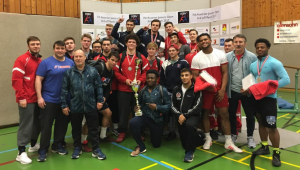
Hancock (third from right) was one of six champions and 12 medalists who helped lead the US program to its most successful team performance in history at the Austrian Open. (Photo: Lucas Steldt)
A week after that glimmering run to gold in Austria was the highly-competitive Croatian event known as the Grand Prix Zagreb Open. A first-round decision over Hungary’s Adam Varga got Hancock started off on the right foot but he fell into quicksand in his next bout against 2016 World University bronze medalist Ilya Borisov (RUS), dropping a 12-4 tech. Since Borisov failed to reach the finals, Hancock couldn’t get pulled into the repechage, making the Zagreb Open his first tournament in two years that would end without a medal match.
Hancock: “Man, Juniors to Seniors is boys to men. That’s why my Junior bronze, I see it as an accomplishment, but I don’t hold it as a title because it’s such a different league. Now I’m wrestling in Croatia as a Senior and it was a humongous adjustment. I’m wrestling guys who are just as strong as me, guys who not only have as many techniques as I do, but probably more counter techniques, too, just because they’ve been around so much longer and have been wrestling Greco since they were kids.
“I’m not going to lie, I’ve watched that match against Borisov with Coach Mohamed (Abdelfatah) probably 30 or 40 times. On repeat. As everyone knows, my favorite move is the bodylock. My best move is the bodylock. Borisov happened to stop it twice and that was a problem for me. When we watched the film over and over again, we saw that the adjustments were not huge. They were very subtle. It was my foot being one inch deeper, my lock being cinched a little bit tighter on the left side or trapping his arms a little bit better. That’s the love and hate for the sport — you could be so close, a fingertip away, and mess everything up. Everything goes in a completely different direction.
“I learned that there. I learned about tiny adjustments. A thing Matt Lindland likes to say a lot, which completely correlates, is that it’s not blacksmithing, it’s more like watchmaking. You can’t just grab a damn hammer and fix a watch, because it’s going to break. No, you’ve got to get a small screwdriver, put your glasses on, take your time, and find out what’s wrong. That’s what we had to do after Croatia.
“It’s the process. At the OTC, you learn a lot of quotes. There are a lot of philosophies to go by with Momir and Lindland being very philosophical wise men. They tell us things like Trust the process, because it doesn’t happen overnight. That’s the 100% God’s honest truth. There are wrestlers I’ve seen who are a living testimony to that.”
April 2017
All season long, the story had been about Hancock, Zillmer, and the presumption that they could be the last two standing to decide the 2017 World Team spot at 98 kilograms. You said could, if only because the prevailing thought was that Rau’s presence might have potentially served to cancel one of the pair out. But with Rau’s decision to move down in weight, 98, once again, belonged to the two athletes whose six-month collision course deserved to end under the spotlight of a best-of-three final.
The series did not reach a third and decisive bout as Hancock swept the first two, although both were tightly contested throughout. Zillmer held a 2-1 lead in Match 1 before Hancock wailed a bodylock for five to snare all of the momentum en-route to a 6-4 decision. The conclusive battle offered a taste of drama when Zillmer appeared to throw Hancock for four only to have the points wiped off the board following a challenge. A passivity point in the second period made the score 2-0 in favor of Hancock and he was able to fend off a late Zillmer charge to claim his first spot on a Senior World Team.
Hancock: “This was bigger than Zillmer to me, it was a lot bigger. It was the preparation and opportunity. Like I’ve said, you train all year for this. You’re so invested in something and all of its stages throughout the process. There are obstacles and then there are trials, that is literally why it’s called the World Team Trials, because it is one of the trials on the way to the main goal.
“I felt like, and I know I use the word a lot, but this was a stepping stone. It was not the big picture, it was an obstacle. The goal is to be the best in the world, so in my mind, this has to be done. There’s no other option than making this Team because of what I put into this. It was my time to show up, my time to represent the USA, and my opportunity to be the best in the world for the best country in the world. And that is definitely bigger than Zillmer.”
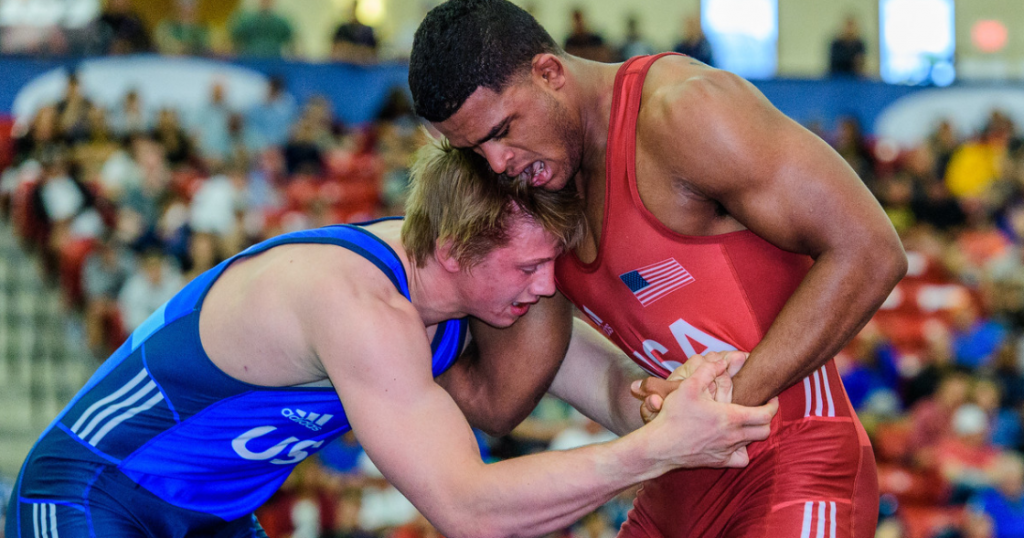
HOW IT’LL BE REMEMBERED: G’Angelo Hancock and Hayden Zillmer ran up against each other in four tournament finals during the 2016-17 season totaling a combined 24 minutes. Nearly every match saw both athletes struggle to find consistent scoring opportunities, but fans remained engaged anyway simply due to the intense, tactical in-fighting that became par for the course. (Photo: Tony Rotundo)
May 2017
Hancock didn’t have to wait very long to see how it felt to compete as a Senior World Team member. One week after the Trials, the US traveled to Cuba for the 2018 Pan Am Championships, an event that will likely remain embedded in the wrestler’s memory bank for the rest of his natural-born life. It has to do with the two main storylines that came out of the tournament. For starters, a fire broke out in the arena on Day 1, resulting in the action being postponed until the next morning. But more importantly, it was right there in Salvador da Bahia’s Pan American Judo Arena where Hancock received the most compelling evidence in his career thus far that he might truly be on the cusp of Senior-level stardom.
His first bout of the tournament is the one he’ll remember most. The opponent was none other than Kevin Mejia Castillo, the burly Honduran who a year prior blitzed Hancock at both the Pinto Cup and Dave Schultz Memorial finals. And the American completely shut him down. An early bodylock takedown followed by another in the second period represented the sum of the scoring, elevating Hancock to a verifiable cruise-control 5-0 victory.
Hancock: “Matt Lindland was super, super nervous for my match with Castillo. The last two times I wrestled him I lost. Honestly, I was just thinking, Yasmany is at this tournament. It’s too late. I stepped on the plane, it’s too late, I’m here to show out 100%. I knew I was going to wrestle him my hardest out of everyone in the entire tournament.
“But yeah, Coach Lindland was super nervous and I made sure I got a really good warm-up and was 100% ready to go. At that point, I felt amazing. I had my music going in my ears, Lindland came over and started rubbing my shoulders and shaking my arms, and I remember telling him, It’s good, it’s good. I’m ready. And he just laid back. I could see he was nervous. But I walked out there dancing like I always do before my matches, and it was a completely different feeling than I used to have.
“I usually would go out there and it’s like, Ooh, I’m nervous. This guy is good, he’s strong, he’s like me. Castillo is very athletic, too, he reminds me of myself. But I don’t know what it was really, I can’t even say. Maybe it was my training or the support I had from the coaches, but something made me feel like, I am going to kill this guy. I am going to dominate him, he isn’t ready for what I have right now. And maybe part of that was because I knew in my next match I’d have the Olympic silver medalist, so I want to let him know I came to wrestle. Heck, I wanted everyone to know I came to wrestle. I don’t know exactly what it was, but I remember that was my feeling before my match with Castillo. After winning that match and knowing I had dominated him, I could say my expectations were met. My tone was set for the rest of the tournament and it didn’t change.
“I also felt like there was a lot to prove at that point, that I’m still that guy. I wanted to see how well I could compete. There were a lot of good names at that tournament and I wanted to see who I could beat. I wanted to wrestle my absolute best and be as technical as I could be. To kind of show my true potential, how I can compete when I am disciplined and still in my stance. It’s burning my legs but I’m still in my stance.”
Awaiting in the semifinals was 2016 Olympic silver medalist Yasmany Lugo Cabrera (CUB) and one of those marquee match-ups young “prove it” athletes like Hancock relish. The Cuban struck first with a takedown. A caution soon after essentially knotted the score, though Cabrera still owned criteria and he’d tack on a passivity point right before the break. Hancock picked up the pace in the second period, digging diligently to create a score. He went for a bodylock, his go-to. With his back to the line, Hancock seemed to have adequate position to complete the motion. But at the last second, Cabrera flopped and floundered just enough to wriggle free and land on top as the two monsters crashed to the tarp. Hancock did manage to net a passive point towards the end of the match, but that would be as close as it got with Cabrera emerging via 5-3 decision.
If there existed a letdown on Hancock’s side of things, it was indiscernible. He was bouncy, aggressive, and in command as he took the mat against Thomas Barreiro (CAN) for bronze. A passive, a takedown, and then an enormous reverse lift good for five points delivered a suitable ending to what had been a confidence-boosting tournament stuffed with more lessons to take home than he probably could have hoped.
Hancock: “If I would have just chilled (against Cabrera) and just stopped and thought, Hey, I have great position, just throw the arm by and get the waist. I could get the four-point throw, or since he’s smart, I guarantee he’s going to go flat. I had great positioning, I had the whole body and he was bent over. Looking back on that match, that tournament, that’s the only thing I would change. I would have just slowed it down because I had the positioning. I realize it now that when I get to a good position, and I know I’m dominant and I’m in control, I have to wait for him to react. That just pissed me off so bad.
“Really, all you ever want when you’re wrestling is a chance at those guys. You pray to God that the tournaments and tours you go on have the best guys in the world there. That’s your goal, or at least it’s my goal, personally. I want to see the best guy at every tournament. I want to know him. Starting the Pan Ams off like that was a gauge for me, knowing I cannot stop because I’m on the right path. Literally during the match I felt it, I felt the decisions being made. I felt the mistakes, too, and now I know the right decisions that need to be made.
“It was my first Pan American Championships, so I was really proud to bring back some hardware. I know it’s definitely a low-ranked tournament. Hands-down, we’re expected to win and get medals. But I took it to heart since it was my first one and it did have meaning to me. I had tough competition in that event. I was happy, you know? Happy but never satisfied. I wanted to beat the Olympic silver medalist and I was so blessed to have that opportunity and be that close to engage and have actual scoring chances against him. I definitely got better from that tournament, so it was a blessing, an opportunity, and also, a lesson. There was so much to be learned there.”
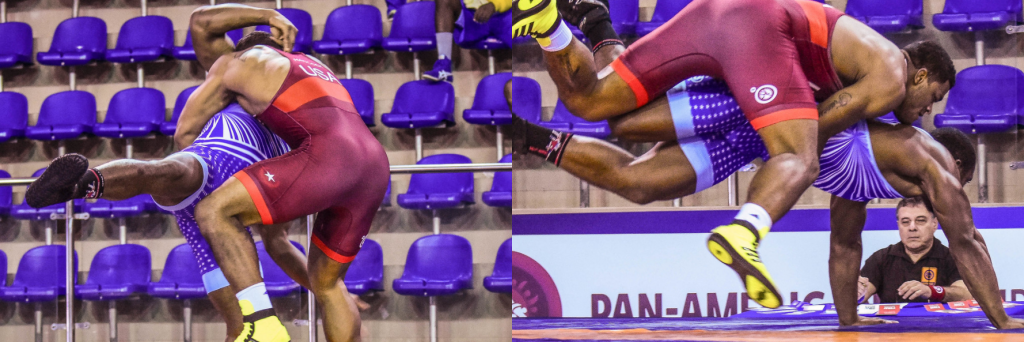
WHAT A DIFFERENCE A YEAR MAKES: Against Castillo in the 2017 Pan Am Championships, the most telling sequence of the bout occurred early on when Hancock plowed his way into a bodylock. But instead of locking and attempting to arch over without the position fully secured, the American chose to pivot angles and go for the higher-percentage takedown, eventually winning the contest 5-0. Castillo had defeated Hancock twice by technical fall the year prior. (Photos: Richard Immel)
June 2017
Hancock earned the right to bypass the Junior World Team Trials challenge tournament that was held in April due to his ranking and and results on the Senior side. Rather than be forced to compete days ahead of the Senior Trials and put his body through an additional weight cut, he instead swooped right into the best-of-three finals against Northern Michigan’s Blake Smith with that series to be contested alongside the University Nationals in Akron, Ohio. Hancock, a returning champion in that age-group, as well, elected to punch the clock for some double-duty, getting past Smith in two straight to start the day before blasting his way to the University finals.
Hancock: “I had everything separated in my head as two different goals because I never had a tournament like that before. Those two matches against Smith had a different meaning, and then every match after that also had a whole different meaning. My goals going in were simple: make the Junior World Team and then become the University National Champion. That’s how I broke it down. After I won the matches against Blake it was, One bird, now let’s use this stone again throughout the day and knock both birds out.
“I felt great about beating Blake because, well, I didn’t get it the year before. I’m trying to get the gold now. It’s a place I was invested in, and to me, it was solidifying myself as a Junior. So beating Blake was my way of helping everyone understand that, Hey, I’m ready for the big show.”
Fresh off of the wrestle-offs against Smith, Hancock met little resistance en-route to the University final. But once there, things took a surprising turn. Opponent Zach Merrill (NYAC/FLWC) became the first American to hand Hancock a loss in 14 months. The two had met previously with the outcome going Hancock’s way, but Merrill presents legitimate problems and is a technically-sound competitor, to be sure. Even still, it was a match-up Hancock expected to handle with relative ease.
But he didn’t. Merrill scored quickly on a misfired Hancock arm throw and then was awarded two points when Hancock got called for a defensive leg foul in the midst of a lift attempt. From the ensuing par terre, Hancock was rung up by the referee for a false start, and then another, giving Merrill two more points and a 6-0 lead. When they returned to the feet, Merrill popped Hancock with his own arm spin, ending the circus right then and there via 10-0 tech. Hancock, exasperated and bewildered when the bout ended, wore a wry smile as he walked off the mat.
Hancock: “Before the match (against Merrill), my goal was to be loose as possible, have as much fun as possible. I really just wanted to go in there with a good mindset and have fun. I wouldn’t say I completely underestimated my opponent, but I did take him too lightly.
“The first caution, I’m like, Okay, shit happens. But when that second caution got called, Oh…I’m really down now. A big move has to be made in order to come back. I was frustrated. I went in there too loose, and plus, now I’m frustrated because I’m getting hit with cautions. So I’m angry. I wanted a cube (for a challenge). I was looking for a cube. But we stand up, I’m desperate, and then he hits me with a mean arm throw. I’m not going to lie, that arm throw was legit.
“I couldn’t complain since I knew no matter what I said or did that the match was over with. Because, I know how it goes when I do it to somebody else. So it was kind of a smiling moment, like, Wow, this just happened.”
August 2017
Two World Championships in the same month might be a lot to take on, for any wrestler, but it was what Hancock graciously signed up for. The Junior version of the event, hosted in Tampere, Finland, came first and loomed large on the radar. The US was returning two bronze medalists, Hancock and LaMont, as well as podium candidates Bey and Miranda. A history-making team effort was expected, and in a way, that’s what happened — Bey delivered an unforgettably exciting performance throughout his surge to the first Junior World title for an American in nearly two decades and fill-in Cevion Severado quieted his sea of doubters by picking up an inspiring silver.
Hancock wasn’t as fortunate. Picked by many to outright win the 96-kilogram class, his advancement through the tournament was cut short in the most cruelest of ways. Hancock held a 3-2 advantage on Suleyman Erbay (TUR) late in the second period of their quarterfinal bout and still appeared in control with time seemingly on his side. Everything changed in an instant. Erbay came in on a body attack, but as he did, he tripped Hancock to the tarp for a takedown. The obvious leg foul wasn’t caught by the official(s) and in another confusing twist, the US side declined to challenge the infraction. Hancock tried to steal back the lead. There were 40 seconds remaining, so it was doable. But the buzzer sounded before he could somehow come up with a score and the result was a hard-to-swallow 4-3 defeat for one of the premier weight class favorites. Erbay was trounced by eventual runner-up Artur Sargsian (RUS) in the semis, erasing Hancock’s ability to at least wrestle back for his second consecutive bronze.
Hancock: “I really did believe, because I looked at Coach Ike (Anderson), that I could still get it done. In my mind I did believe that, Oh, I can definitely come back. It brought me back to how Momir would orchestrate practice situations. I’d get an awesome throw or takedown on someone in a live match in the middle of the mat and Momir would say something like, No points. Back on the feet. I’d look up at him, What? And he’d say, ‘The ref was Russian.’ And then I would have to get another takedown because the last one didn’t count.
“Momir would say that jokingly, but when this happened it was playing in my mind just like that. Okay, forget about it, it’s a Russian ref. That’s what this brought me back to, Momir’s way of telling us that, Hey, sometimes things aren’t going to go your way even if it’s by the book. Even if you do things by the book, they won’t go your way sometimes. So I said, Alright, let’s go. I actually did believe in those last 43 seconds that I could have gotten a takedown, and I came up short. 100%, I came up short. But that’s what was running through my mind.
“There was an expectation I had for myself and it wasn’t met. Like I said about Hayden Zillmer and the Trials, that wasn’t the main goal. The main goal is to be the best in the world. The Senior World Championship was the main goal and the trial, in this case, was the gold medal at the Junior Worlds. And that stung me really hard. It stung me really hard. There was a plan, I had blueprints that I had thought were written so well. The plan was to train hard, go to the Junior Worlds, win the Junior Worlds, and with that motivation and fire, you roll into the Senior Worlds and go kick ass. It’s a huge, huge, huge reset. You know how it feels when things don’t go as planned, right? Well, this was a huge setback.
“The main thing I was trying to convince myself of was that I had a minor setback and it would result in a major comeback. That was the big thing I was trying to convince myself of, that I had to have this minor setback personally because a Senior gold medal would wash it away. In my mind, if I would be able to bring back the hardware from the Seniors, that would take this burden of disappointment off of myself.”

Hancock began the 2017 Junior World Championships with back-to-back tech falls over Switzerland’s Damion Von Euw (“He’s a great friend,” says Hancock) and Bulgarian Kiril Milov (“Just super-awkward, he kept waiting for me to do something so he could react. He didn’t need to wait long.”) But his quest for a medal was thwarted when Suleyman Erbay (TUR) scored late in the second period of their quarterfinal contest after a visible leg foul, giving Hancock a 4-3 loss that prompted many US fans who saw the action live to issue complaints via social media to United World Wrestling regarding the missed call. (Photos: Richard Immel)
Rather than fly home, Hancock stayed in Europe to complete his preparation for the Senior World Championships. It was a long time to be away from familiar comforts. From friendly faces. Reassuring voices. But it wasn’t a byproduct of his occupation that Hancock could gripe about. He knew the stakes. The Junior tournament had its place and success in Tampere likely would’ve been briefly acknowledged just ahead of some phraseology declaring how that was just an appetizer for the Senior event. Or something to that effect. Even Lindland, who exhibited more enthusiasm for the Americans’ chances in Finland than anyone else, said beforehand that whatever Hancock accomplished there was to be seen as a warm-up for the big show in Paris.
So there wasn’t time for a whole lot of wallowing. Hancock had to move on right away and re-shift his focus to the Senior Worlds, though the perception surrounding his candidacy at that tournament offered a different complexion. Was he a legitimate, capable medal contender? Maybe. Probably. Depending on the draw, plenty of observers believed Hancock could potentially wind up in the running. But was he a favorite? Certainly not. That distinction unanimously belonged to Artur Aleksanyan of Armenia. At only 25-years-old, Aleksanyan entered Paris having already established himself as one of his generation’s most recognizable faces with golds at the three previous World-level events in addition to three titles from the European Championships. It’s a resume reflective of both dominance and competitive maturity that very few Greco-Roman stars even approach midway through their Senior careers.
As luck would have it, Hancock not only got his crack at Aleksanyan, but he was also walking into an opportunity to immediately grab a measure of revenge. In the qualification round stood 2016 University World Champion Fatih Baskoy of Turkey. There was no personal history between the two; no ill will, bad blood, or any other visceral component worth mentioning — except for where Baskoy was from. After the way Hancock was sent packing at the Junior Worlds by Erbay, he had secretly hoped that at some point down the line there would be another Turk for him to do business with. The fact that Baskoy resided higher on that country’s depth chart than Erbay only sweetened the deal.
It wasn’t an offensive bonanza but Hancock was able to methodically take Baskoy out of his game thanks to some steady pressure and a pair of passivity points. By the middle of the second period the situation was hardly in doubt. Unlike the harrowing one-point lead Hancock held against Erbay — who to his credit never really relented in that match before the deciding leg foul — there was not a detectable sense of doubt or any white-knuckle exchanges late in the second period. Baskoy was worn out down the stretch and barely hanging on. He just wanted it to be over and soon enough it was, with Hancock the winner of a crisp 3-0 decision.
Hancock: “That was destiny. Hands-down, that was set up by someone upstairs looking out for me. I was so happy. It was a feeling of redemption, a feeling that this was designed for me. Wrestling is an individual sport, to a large degree, and there are personal things you carry around. Some guys have rivalries with certain countries and stuff like that. I don’t want to say that I had a beef with Turkey, but I knew that next time I was going to have a Turkish wrestler there would be something to prove. I wanted to prove that USA beat Turkey in that match (at the Junior Worlds) and by starting off the tournament this way, it motivated me personally as if to say, This is good, this is my chance at a comeback.”

It might not have wiped away the loss at the Junior Worlds a few weeks prior but Hancock still liked having the opportunity to earn a win against Turkey. Here he is trying to move Fatih Baskoy with a two-on-one in the qualification round of the 2017 Senior World Championships in Paris, France. Hancock won the bout 3-0. (Photo: Tony Rotundo)
Aleksanyan is a large-enough name to offer an ample amount of mystique. First-time opponents have shown to be hesitant navigating their respective ways into tie-ups, this despite Greco-Roman’s strict rule-set that penalizes a lack of engagement. Newbies are often wary about clawing inside, but not because they are afraid to be thrown or physically punished for displaying such moxy. It has more to do with a reluctance to get pushed around by the chiseled, lumbering Armenian with little recourse at their disposal. Because for as dynamic of a big man Aleksanyan is and can be, he has also benefited greatly from a shrewd usage of passivity. Since he is rather difficult to move off his spot, and at the same time can erupt into a fluid-but-volcanic scorer, there are some wrestlers inexperienced to his ways who allow him to determine the tempo just so they have a feel for what it is they are up against. By the time these athletes realize that Aleksanyan is indeed human, it’s usually too late for them to inflict a mortal wound.
Hancock employed a starkly different strategy. Rather than probe and prod, he went after Aleksanyan with ferocity, if not reckless abandon. There has always been a smoothness to Hancock’s style, an ease in which he could work inside and nurture meaningful tie-ups preceding his more high-octane maneuvers. He possessed this skill-set even before he fully understood the intricacies and nuances necessary for Senior-level competition. Against Aleksanyan, it was a 180. Hancock eagerly raced into the bubbling cauldron every chance he could. The World Championships, with its grandness and splendor, is hardly the time to betray any sort of trepidation. But the turbocharged pace Hancock was setting caught everyone a little off-guard, including Aleksanyan, who was forced back onto his heels.
Whether this was all Hancock’s way of declaring that he wouldn’t go down without a fight — or rather — a calculated method of operation he and the coaching staff felt provided the best shot at slaying the giant — is up in the air. Either way, it had a shelf life. Halfway through the first Aleksanyan reset his feet to olé Hancock off the boundary for a step-out point. Later in the period, the Armenian used underhooks to secure a takedown. Down 3-0 entering the second, Hancock’s consistent pressure yielded him a passivity point. He was staying in this thing. But before he could capitalize further, Aleksanyan cracked open a window to the body and collected four. The US challenged the sequence and lost, making the score 8-1. One more Aleksanyan takedown with a little over :90 remaining iced the bout altogether.
Hancock anticipated this match-up well in advance of the tournament. It was one he desired. To win a World title, wrestlers have to beat everyone, anyway, for it is foolhardy to depend on the top guys getting knocked off by someone else, the dirty work being done for them. But if unable to emerge victorious, their next best option is to embrace the newly-acquired knowledge and store it for later application.
Hancock: “I wanted him to remember me. That was my goal, so he would realize that the last time he wrestled an American, it was hard, very hard.
“I knew before the tournament my ranking wasn’t going to be high and that I would have Artur soon, very soon in my bracket. Ever since middle school, I’ve always been saying that ranking is nothing but ink on a piece of paper. And what I really want Artur to know, because in my heart of hearts right now I believe this, is that I will be the one to take him out. I believe that I will be the one who takes out the Armenian, 100%. That will be the match of the century. There is no other wrestler like him currently and I guarantee that I will be the one who takes him out.
“I learned that he was very disciplined. I felt while wrestling him how disciplined he was. He didn’t open up once on me, he didn’t break position on me a single time. But everytime he moved it was for a purpose, and I knew why he was blocking. I felt his experience. He definitely knew what he was setting up, which is why when he did move, it was very powerful. But as I was wrestling him I didn’t feel too far off. Looking at it now, I learned a lot. It goes back to that whole thing about blacksmithing versus watchmaking. This is watchmaking. There are very small things I have to work on, such as creating angles and how I open up an opponent instead of just blasting away at him. There are still experiences and technicalities I have to pick up. I have to respect everyone, but at the same time, respect no one on the mat. I respect his discipline and love for the sport, but I have to elevate myself to that level of wisdom so that my wrestling is ready.”
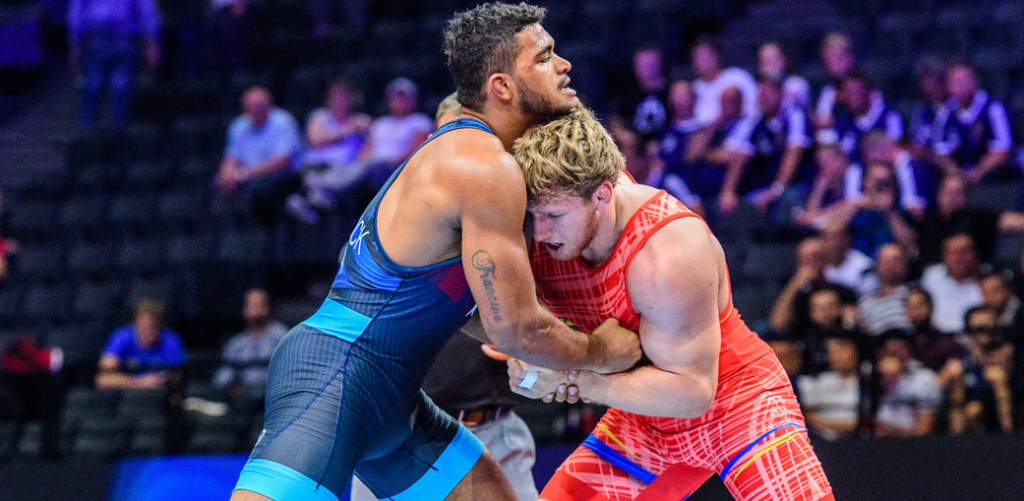
Hancock’s stated goal against three-time World Champion/two-time Olympic gold medalist Artur Aleksanyan was to leave a lasting impression. It may have worked. Early in their round-of-16 bout at the 2017 Senior World Championships, Hancock brought consistent pressure and forced the Armenian to adjust to the pace. However, Aleksanyan tacked on a bevy of points in the second period to walk away the winner before sealing up his third World title later on that day. (Photo: Tony Rotundo)
The other fortuitous byproduct of wrestling Aleksanyan for Hancock was its built-in contingency. No wrestler would or will ever say it (and certainly not before or during an event), but the principle bonus that resides in facing an opponent who is expected to contend for gold is that it instantly increases the odds of scoring a bronze medal. This is due to the system in place at most international events and definitively at the Worlds and Olympic Games. A loss to an eventual finalist pulls a wrestler back into the tournament’s repechage, where he or she will then battle others vanquished by gold medal candidates on their side of the bracket. Thus, a “bad” draw for an international Greco-Roman competitor is not wrestling a weight-class favorite prior to the semifinals, but being bracketed opposite tough, capable potential medalists, or simply opponents whom offer significant match-up problems but aren’t observed as actual contenders to advance to the finals.
2017 Asian Championships winner Seyedmostafa Salehizadeh (IRI) was Aleksanyan’s first victim of the morning, so it was he and Hancock for the first 98-kilogram repechage match. Salehizadeh had come on in a big way prior to the Paris Worlds, scoring a gold at his home country’s Takhti Cup in January and putting in a strong all-around performance at the World Cup in March. A solid test for Hancock, that’s what this was. And while he did not charge after the Iranian the same way he did Aleksanyan, Hancock still attacked with enough conviction to earn the first passivity point of the contest, which is always considered a sort of moral victory in itself for Americans. Salehizadeh answered back with a step-out shortly thereafter and picked up a passive point of his own just as the first period ended. Hancock fired out of his corner for the second but found trouble exploiting any of Salehizadeh’s perceived vulnerabilities, namely his tendency to lean. Eventually, Hancock was nailed for a second passive, and although he tried mounting a furious rally with little time remaining, he couldn’t make up the difference, falling 3-1 to wrap up his first Senior World Championships appearance.
Hancock: “Before I wrestled the Iranian I was like, I’m ready to die for this. This is my last shot. If I lose this match, I’m done. So that’s what I was thinking, I’m ready to die for this. And it didn’t work out. I’m trying to open shots up and this dude is so tight. He earned more passivities than I did without actually being aggressive. After the match I was crushed. Crushed. You know, you have to do those interviews right after the match and I’m like, Jeeze, let me hold it together for another three minutes so this dude can ask me questions. But I was crushed.
“You know, you want to say, Oh, I’m a top-tier guy, but you question it. Looking back now, I see the mistakes that need to be corrected. It’s the process. But in the moment, you question your training, your preparation, if you are in fact a top-tier guy. You know what I’m saying? You are given an opportunity and you don’t make something out of it. So you kind of question all of it.
“I’m crushed, hands-down. Coming off of the Junior World Championships, a tournament I’m supposed to win and I end up with all of that happening, and then comes the Senior World Championships and I just get blown out of the water. It was definitely a devastating moment. Usually I’m like, Okay, back to the drawing board, it’s time to get after it. This time, I wanted to go to my coaches and get guidance from my mentors to see what I did wrong and what my next steps would be after this. And maybe with this being my first Senior Worlds I didn’t know what was next. Now that time has passed, I realize that I have another shot, but I don’t want to view it as, Oh, I get a shot every year at the Senior World Championships. I’m getting older every day and I have to make each opportunity count when I get it.”
October 2017
Not quite two months after the Senior Worlds, Hancock returned for an attempt at securing a spot on his third World Team of the year. The U23 World Team Trials in Rochester, Minnesota declared itself on the calendar like a welcomed beam of sunshine following seven weeks of cloudy days, sleepless nights, and difficult questions that weren’t going to be answered anytime soon.
Maybe Hancock could rinse some of the bitterness out of his mouth Tampere and Paris put there. He seemed to believe that was a possibility. A gaggle of coaches and fans wondered if a break might’ve suited him better. Hancock wondered, too. But he was going to show up. Ho-hum, another Trials tournament where he would be favored to wreck the joint on the way to one more coronation. If anything, the most newsworthy item shadowing Hancock’s entry into the U23 Trials had nothing to do with his participation and everything to do with the weight class.
In lieu of additional time off, Hancock’s “break” arrived in a different manner. He didn’t have to cut. Hancock had sought the counsel of his coaches and the consensus was a jump to heavyweight might loosen him up. You could see it, this wasn’t an outrageous suggestion by any stretch. Hancock was/is on the larger side of 98 kilograms and his height beckons for some extra density. One of the perks of being young. But the new weight class also offered intrigue. Hancock had always been effective muscling domestic 98’s around whenever he needed to. How his power and explosiveness would translate when run up against much-more massive opposition provided onlookers with a fresh reason to keep paying attention.
Nick Boykin (Sunkist), the robust prospect from Tennessee who is also an Olympic Training Center resident athlete, was Hancock’s semifinal opponent. The familiarity between the two, evident in each exchange, didn’t exactly lend itself to providing fireworks. Hancock scored on a counter to a headlock and then again off of a nifty arm drag. The most telling sequence came later in the first period. As Hancock tried loading up for a lift attempt, Boykin wriggled free and reversed, receiving two points for the exposure. The second period didn’t see a change in the script. Boykin remained in the fight for most of the three minutes with a Hancock slide-by for two serving as the dagger in what was a 7-2 decision.
The same amount of trouble was not present in the 98-kilogram finals series. Versus Alton Meeks (Florida Jets), Hancock ran away with back-to-back tech falls to snare a place at the inaugural U23 World Championships in Poland six weeks later. All in all, it was the same Hancock, just in a new weight class — the only half-rest he was going to get for the foreseeable future.
Hancock: “I just finished with both of those World Championships and I went to my coaches. I kind of wanted a break. It was a tough place to be mentally. I just wanted a small break before I got back to wrestling. I was told, So wrestle heavyweight. You get to eat, and for a wrestler that is kind of a break (laughs). I basically said, Screw it, that sounds good to me. I’ll wrestle heavyweight and enjoy myself for a few weeks. I’m going to get fat, have fun, and wrestle for the heck of it. I’ll weigh in with a can of Pringles and some Gatorade. I did that and had a good time. I had an amazing time at U23’s. I felt really good about that.”
“I didn’t see the U23’s as downtime or something less spectacular. To me, it was still a chance at another World Championship. I really was going into this figuring I’ll at least get some interesting matches if the opportunities presented themselves. I considered myself a competitor at heavyweight. I engaged the weight class. I put the weight on and I thought, Maybe I can give this thing a shot to see what heavyweight guys have. I was also interested in seeing how my body holds up. I’m 20 years-old, six-feet tall, and I can get up to 230 pounds, cutting 15 pounds to make 97 kilos. I cut eight kilos easily. I wanted to experiment, asking myself, Is this the weight I’m going to be at for 2020? Is this going to be my weight forever? At that point in time, I wanted to see how I could adapt and see how heavyweights felt, how a new weight class feels. U23’s was a bigger opportunity than expected but it was one I wanted to take advantage of.”
November 2017
Similar to Hancock’s training prior to the duo of World Championships in August, he was called upon to do the bulk of his prep in Europe (and he wouldn’t wind up coming home for quite a while after that). The first stop of the trip was Grodno, Belarus. Hancock, along with six other US Seniors including three fellow U23 World Team members (Bey, Barrett Stanghill, and Blake Smith) participated in a joint training camp, but the real highlight was a special dual meet with a group of Belarusian wrestlers. Held in an all-purpose community center that also doubled as a nightclub, the atmosphere was something the American athletes rarely experienced — fans going crazy for Greco matches. While it helped that he wound up victorious in a 4-2 decision over Maksim Paskov, Hancock can’t help but remember the event fondly for the unique environment that it offered.
Hancock: “That was the most awesome event I’ve ever been a part of. I had never experienced something like that before in my life. It was like a high school dual on steroids. No, it was like an Iowa dual. The people just filled this small arena and they had dancers, they had a halftime show with girls dancing to these songs. When we wrestled, we came out to music. It was a badass spectacle. Belarus came out from one side, then the USA came out from the other side, and people in the crowd were holding flags for both countries. These were foreign people holding American flags. We were like, Okay, let’s put on a fricking show! To me, it was more about entertainment, to show out. I also felt it was a great way to have my first overseas match at heavyweight. I was all like, Let’s get it!”

Hancock receiving instructions from US National Team head coach Matt Lindland in between periods at the USA/Belarus dual in November. (Photo: Yaroslav Vaniukievich)
Heavy anticipation surrounded Hancock at the Junior World Championships, deservedly. An argument could have also been made that there was a sufficient level of confidence enveloping his chances in Paris, for a medal there wouldn’t have brought with it a ton of shock value. But an air of uncertainty hung over the U23 Worlds. For starters, plenty of accomplished candidates were going to be parked all over the 130-kilogram bracket. There was also the little matter of Hancock’s ongoing adjustment to the weight class, of which he had precisely three official matches in, since the Belarus dual technically doesn’t count on his record. But what he did have working in his favor was the proverbial x-factor. Hancock wasn’t going to be bigger and stronger than the lot staring him down inside of the Artega Arena in Bydgoszcz, Poland. But he did have quickness, agility, and one helluva bodylock in his pocket. A puncher’s chance, there was.
And that trusty bodylock helped escort Hancock to victory in his opening bout. Romanian Lenny Berei received a crash course on its applications midway through the first period, though he battled back with a correct throw, a takedown, and then a step-out to go up 5-4 in the second. To Hancock’s credit, there was little sign of panic. He regrouped enough to gather a takedown of his own off of an over/under slide-by before immediately transitioning to back-to-back gutwrenches. Just like that, Berei’s 5-4 advantage became a 10-5 deficit and Hancock cruised to the round-of-16.
Hancock: “I caught him with my first bodylock and he wasn’t expecting it. I was definitely way faster than him. When I went for my second bodylock, he immediately knew. I felt it. You know when you have the bodylock or not, you kind of have the feeling, and I felt distance. Wait a minute, he’s onto me. So when I went for it that second time, he sank all of his weight down and I was like, Oh man, there’s no way I can control this big body.
“Winning that first match was kind of my invitation to the tournament and that wasn’t even a round-of-16, it was a qualifier. I was in the big boys’ league, there was no other way to put it. That’s what was going through my head, Okay Tracy, you’re in the big boys’ league. You have to be more agile, more active. I was expecting bigger opponents, so it was good to have that first match out of the way. I was now actually in the tournament, seeing it as, Alright, now I am a competitor. It was just odd thinking that way as a heavyweight because I know I’m more than just a competitor at 97 (kilograms). That is hands-down my weight class, and it will always be. That’s why it is kind of weird for me to say, Oh, I’m a competitor. I don’t want to ever, ever, ever, ever be just a competitor, I want to be the champ. But at heavyweight, that’s what this was. It was a whole different world and I had to respect that weight class. I was just introducing myself there as a competitor.”
Whatever good tidings arose following the win against Berei were quelled by 2015 African Championships gold medalist Abdellatif Mohamed (EGY). Mohamed, a verifiable truck of a specimen, used his considerable mass to put Hancock in reverse, resulting in a penalty and two points for the Egyptian. Another tick went up on the scoreboard soon after for passivity and Hancock, down 3-0, appeared stymied. He couldn’t respond in kind, not in the way he was accustomed to. Mohamed kept coming and a four-point bodylock all but knotted any remaining loose ends. Behind 7-0, Hancock was just about out of answers, though Mohamed still required one more point, which he collected on a step-out to speed up the match’s startling conclusion.
Hancock: “During the match all I kept thinking was, This is the taste, the full platter of what heavyweight is. This is what it’s going to feel like. Going into the U23 Trials, I just wanted to give this heavyweight thing a shot. The match with the Egyptian gave me a whole new perspective on how heavyweights move, how they wrestle. I wound up getting thrown and that was absolutely insane to me (laughs). It killed me, I was like, Oh my God, this is an entirely different style. When he got underneath me, the maneuvers that worked for me at 97 did not work here. At 97, I love it. It’s finesse, I’m using finesse. I can use my weight, my momentum. It’s more of a dance. At heavyweight, it’s a rumble. When he got under me with the power he had, it was a whole different style of wrestling. But it gave me the full taste of heavyweight so I knew what to look forward to and what I had to bring to the table to wrestle with these guys.”
December 2017
International wrestlers don’t measure years the way the rest of us do. Rather, they tend to abide by competitive seasons, from one World Championships to the next in virtual perpetuity throughout their careers. That calendar dangling on a thumbtack in your kitchen? Yeah, it doesn’t really mean all that much to someone who observes the passage of time based on accomplished goals, or lessons learned through suffocating disappointment.
If Hancock had packed his bags and gone straight home after the U23 World Championships, he would have had no choice but to dwell on the result and respond to questions he wasn’t yet fully ready to answer. He wasn’t alone in that regard. The entire team performance in Poland went awry — and quickly. Like dominoes they fell, one after another, over the course of two brutal days that nearly sapped away all of the shine built up during the summer with the two individual age-group World Champions. Hancock was already shouldering a substantial amount of the criticism coming from the outside; had he returned to Colorado with his training situation now in-flux, the echoes reverberating through his brain wielded the necessary potential to allow seeds of doubt more room to grow than usual.
Luckily for him, that wasn’t going to be a problem. Hancock had planned to remain overseas right up until Christmas and the proceeding stop on the dial proved to be one of his favorites. Together with a group of other US Seniors, he set out to St. Petersburg, Russia for what wound up becoming a competitive experience that served as both an antidote for the doldrums, and a reminder why he fell in love with the sport in the first place.
Hancock: “You know what it’s like being a Greco guy. Growing up, all you hear about is (Alexander) Karelin and how the Russians are the greatest wrestlers out there, or the Iranians. And I was just beyond stupid-pumped to go to Russia, Oh my God, I’m in Mother Russia. I was so happy to finally have the chance to say Da svidania (goodbye) to people.
“Going into the tournament (2017 Jouri Lavrikov Memorial) I was like, Dude, we’re going up against Russian wrestlers! It was a whole new motivation, I felt like Rocky against Drago. Everytime you wrestle a Russian it’s a thrill, so actually being in Russia made it even better. It was a different atmosphere. This was their hometown. And then training with those guys and seeing how they train? It was such a blessing. It was an honor because it was just so different, and I was thrilled to be a part of it. The coaches were so nice and everyone was so great there. I spent an hour after practice on the third day one-on-one with the Russian coach and one of the wrestlers who could translate, and he was showing me this two-on-one to a go-behind. We practiced it for an hour, literally, one hour straight, one move, and it was just so I could get better at it. I’ve always had coaches where we’d work on something for 30 minutes and after it would be like, Okay, keep working on that, take your time, we’re going to come back to it. This coach never left my side the entire time. Every time I did the move, he came and showed me what was different. The experience of training and being taught by a Russian coach in Russia, it was just beautiful.
“It was a smaller tournament. Some of the guys were saying it was sort of like the Dave Schultz Memorial in the US, but I’d say it was of an even smaller scale than that. But the crowd was amazing. They were so loud and it wasn’t even a huge crowd. It was a loud crowd, a Russian crowd. They are just so engaged with the sport of wrestling and it is one trip I’m looking forward to taking again in the future.”
A week later, one more sip from the glass of spiritual rejuvenation offered itself, and in somewhat-unlikely fashion. The annual Haavisto Cup, Finland’s longstanding year-end tournament American wrestlers have traditionally performed well at, provided Hancock with one of the most satisfying victories of his career. Following two tough wins (one was tougher than the other) against Tuomas Lahti (FIN) and Stepan David (CZE), respectively, Hancock reached the 130-kilogram final opposite 2017 U23 European Championships bronze medalist Oscar Marvik (NOR). Skilled in just about every facet of Greco-Roman and with the physical structure of a beastly defensive lineman, Marvik wasn’t anonymous to the US delegation. Earlier in 2017, the Norwegian had earned a close decision over multi-time World Team member Robby Smith (NYAC), who was just returning from surgery at the time. Even with that, there was no questioning the type of issues an athlete like Marvik presented. If there were oddsmakers available for wagers, the line on this bout wouldn’t have appeared very favorable for undersized Hancock — something he was indeed aware of before and during the contest.
Hancock: “I remember as soon as he made contact, I took four or five steps back. I had no game plan, the only thing I was thinking was Oh shit! This guy came out so strong. The adrenaline was just going through the roof. I had to try and adjust, this guy has been around, he knows his stuff. I didn’t know how I was going to get the win. If I’m being 100% honest, I didn’t know how. I just knew to wrestle, wrestle, wrestle and move, move, move. I was trying to make him step and regret. I wanted to make him step too heavy and then use his weight against him.
“I really had no idea it would come off of his arm throw. He arm-threw me and I was scared. I actually reacted to get up so he didn’t finish for the pin — and then I got lucky enough to have sprung up so fast that he hadn’t recovered from his arm throw. So as I got up, I just ran at him as fast as I could. It was just like middle school wrestling, you run the monster. You get one arm under the head and grab a little headlock. I just ran it on him and it was insane. And he didn’t even really bridge. You know how foreigners are when they get on their backs, they just lay flat because they think the match is over (laughs). I looked up at the ref and when he blew the whistle, I was like, No way! If you watch the video and see me celebrating, you can tell how I pumped I was.”
“This opened my mind again, more than I anticipated. There are a lot of things that go running through your head after a tournament like this just because of the new weights and weigh-in procedures coming the next month. So thinking about it afterwards, it was, Well…potentially…I could get big enough… Heavyweight still seemed like a possibility. I looked at the pros and cons of putting the weight on. Would I lose my speed and lose my agility? How would my joints feel? Or, how about losing the weight? How is my body going to hold up? How is my shoulder going to feel? My knees? A lot of questions arose from Finland but the good thing that came out of it was knowing whichever weight class I went, I could still do the damn thing. It was a good feeling to be able to have that choice.”
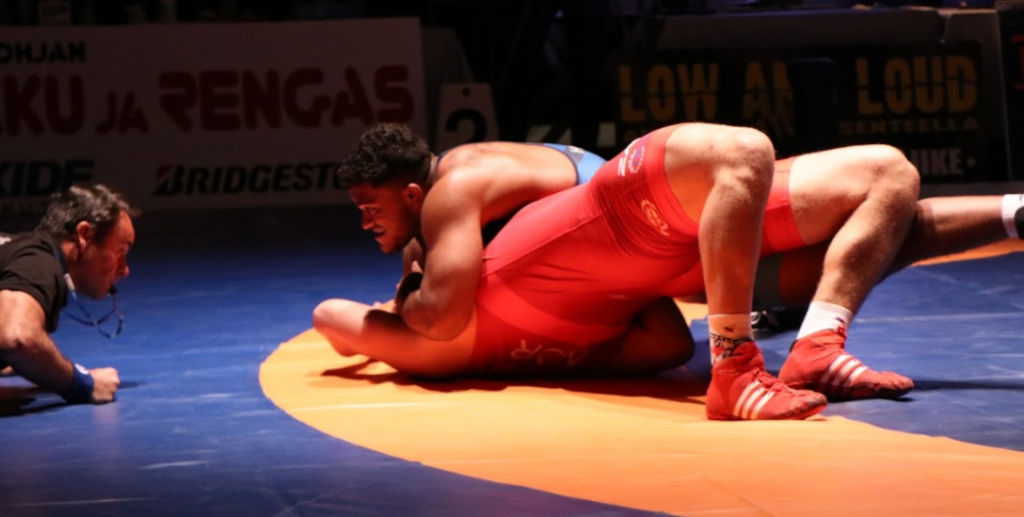
Norway’s Oscar Marvik raced out to a 4-0 lead on Hancock in the finals of the 2017 Haavisto Cup in Finland thanks to an arm throw. However, Hancock bounded up immediately, catching Marvik by surprise just before torquing him straight to his back for a surprising fall. This 130-kilogram bout was not only Hancock’s last of 2017, but will also be his last at heavyweight for the time being. The 20-year-old is venturing back down to 97 kilos once he returns to competition this spring.
Epilogue
The original intent of this retrospective changed throughout the months it was worked on. Initially, the plan was to simply list all of Tracy’s various accomplishments prior to the new year and maybe go and grab him for some quotes that would appear beneath each header. Something substantial — of course. This was never meant to be a seven or eight-hundred-word article briefly recapping 24 months of Greco-Roman wrestling tournaments. That would have missed the mark and it’s certainly not the approach myself or anyone else associated with Five Point Move would ever employ in regards to an athlete’s career no matter who they are or what their perceived standing is.
But after the first batch of months were being drafted, the direction changed to a much more involved undertaking. Hancock was in Belarus when the idea for this piece was conceived. I had reached out to let him know this was a project that interested me because we were approaching the two-year anniversary of those matches against Castillo. To me, that week in January of 2016 is when his Greco career really began. He had enough prior experience to where dialing this back further would have been acceptable, but the Jack Pinto Cup and the subsequent Dave Schultz Memorial offered a meaningful starting point, especially considering how quickly he developed following those two events.
I’ve dealt with Tracy a lot, he knows me as well as I know him. We trust each other and there is a mutual respect that exists between he and I. That made it very easy for him to get on board with what I was proposing. There was no hard sell, and that’s what makes this whole thing even more satisfying, and also, more revealing. Tracy was enthusiastic about the concept, but not in a self-important way. Don’t misunderstand — he is definitely someone who knows how to talk. He gets that there are buzzwords and quips that’ll elicit a reaction. And it’s not a total fake-out. The kid is confident. Extremely. Naturally, confidence can often be mistaken for arrogance, and thus, it’s one reason why his reputation has taken a hit in the eyes of those who have never bothered to actually get to know him. It’s the only downfall in Tracy’s dialogue being transcribed and not released in audio format, for anyone listening to these recordings would be able to hear for themselves the passion in his voice when relaying details from events. But that’s the privilege of the trust factor; he at least knew I’d do what I could to make sure that joy came through in his words.
Which is why he was excited about participating, and consequently, why this endeavor had no choice but to expand. I wanted Tracy to do his best to re-live everything having to do with his competitive career the past two-plus years; and he wanted the chance to show that he wasn’t the cocky, ungrateful smartass some in our sport have made him out to be. He didn’t have to try very hard. Tracy spoke “on the level” and never once had to comb through his brain to remember details. Whether the situation being discussed was a big win or deflating loss, he was pleased to open up and talk about it. Even those defeats at the Worlds, Tracy couldn’t let go of how drop-dead appreciative he was for these experiences. Mistakes on and off the tarp have undoubtedly played a role in helping him realize how fleeting such opportunities can be.
At the risk of sounding trite, this has been a joint venture based on the belief that this a story worth telling just as much for what it is about as who it is about. Tracy G’Angelo Hancock didn’t have to become an international-caliber Greco-Roman competitor. He could have been swallowed up by the less-than-perfect circumstances from whence he came, or the typical problem-case underachiever who never happened upon the temerity to dream big just because every instinct suggested that it was safer to aim small. Hancock, for all of his gifts and flaws, is daring to dream big. And given how quickly he has made an impact along with how much he’s grown personally, it is something that deserves to be acknowledged.
Below is how Hancock summed up his perspective on the project and how it feels to look back on the past two years.
“It’s kind of like that quote attributed to Confucius, ‘If you choose a job you love, you never have to work a day in your life’. There is nothing I regret about the past two years. It has been a process. If I regret anything, I just wish I could go back day-by-day and be more grateful for each one of them, and be more involved in each one of them. When I look back, there were goals set and achieved, and then there were goals that weren’t reached. I thank God there is a next year for that. But I don’t regret any of it. This has all be one huge learning experience and I just thank God that I’m young. Youth is definitely not an excuse that’s on my side, but I do thank God that right now it is.
“I just want to invest even more towards the future and into every one of my training days now that I know what they’re worth. I’m grateful that I’ve had the privilege of being with these top wrestlers in the world, these Olympic medalists, gold, silver, and bronze. I’ve been able to compete against every medal color. I know what each one feels like and that is a blessing in and of itself. I don’t know how many other wrestlers have even been exposed to that, getting a shot against every medal shade from the Olympic podium. The fact that I’ve been able to be exposed to that is such a gift. Now, it’s all about personal growth. Every last bit of it. That, with my wrestling career, has become my focus. I think I’m one step closer to my personal growth. Now I am equally concerned about what it is going to take for me to be the best person I can be on the mat and off the mat. And of course, I still want to be a complete champion who dominates everyone. And I know how to do that.” — Tracy G’Angelo Hancock — April, 2018
CLICK HERE TO DONATE TO THE USA GRECO-ROMAN PROGRAM
SUBSCRIBE TO THE FIVE POINT MOVE PODCAST
iTunes | Stitcher | Spreaker | Google Play Music | RSS

Notice: Trying to get property 'term_id' of non-object in /home/fivepointwp/webapps/fivepointwp/wp-content/themes/flex-mag/functions.php on line 999

